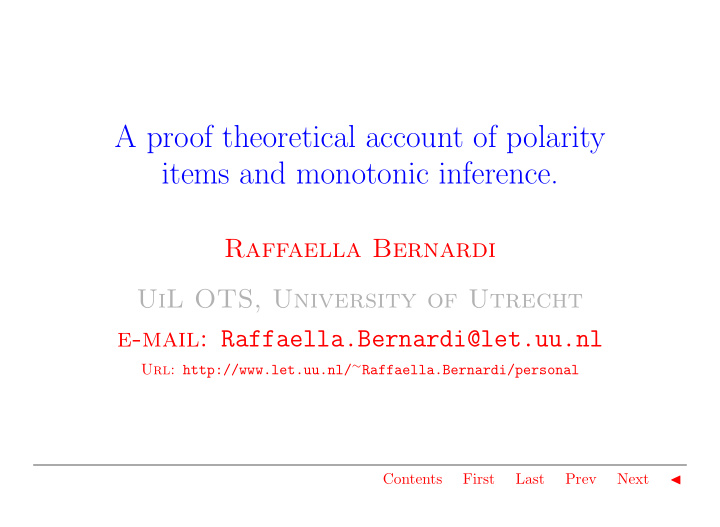



A proof theoretical account of polarity items and monotonic inference. Raffaella Bernardi UiL OTS, University of Utrecht e-mail: Raffaella.Bernardi@let.uu.nl Url: http://www.let.uu.nl/ ∼ Raffaella.Bernardi/personal Contents First Last Prev Next ◭
Contents 1 Monotonicity Calculus . . . . . . . . . . . . . . . . . . . . . . . . . . . . . . . . . . . . . 3 2 Polarity and Monotone Positions . . . . . . . . . . . . . . . . . . . . . . . . . . . . 4 3 Partial Order . . . . . . . . . . . . . . . . . . . . . . . . . . . . . . . . . . . . . . . . . . . . . 6 4 Semantics . . . . . . . . . . . . . . . . . . . . . . . . . . . . . . . . . . . . . . . . . . . . . . . . 7 Contents First Last Prev Next ◭
1. Monotonicity Calculus h : A z → C f ◦ g = h h : A sg (+ , +) → C ↑ Mon ◦ ↑ Mon = ↑ Mon h : A sg ( − , − ) → C ↓ Mon ◦ ↓ Mon = ↑ Mon h : A sg (+ , − ) → C ↑ Mon ◦ ↓ Mon = ↓ Mon h : A sg ( − , +) → C ↓ Mon ◦ ↑ Mon = ↓ Mon Contents First Last Prev Next ◭
2. Polarity and Monotone Positions Definition [Polarity of Occurrences] Given a lambda term N and a subterm M of N . A specified occurrence of M in N , is called positive ( negative ) according to the following clausules: i. M is positive in M . ii. M is positive (negative) in PQ iff M is positive (negative) in P . iii. M is positive (negative) in PQ iff M is positive (negative) in Q , and P denotes an upward monotone function. iv. M is negative (positive) in PQ iff M is positive (negative) in Q , and P denotes a downward monotone function. v. M is positive (negative) in λX.P iff M is positive (negative) in P and X �∈ FV ( M ). Definition[Monotone position] Let N ′ α be a lambda term like N α except for containing an occurrence of M ′ β where N α contains M β , Contents First Last Prev Next ◭
] f i. N α is upward monotone in M β iff for all models and assignments [ [ M ] M ≤ β ] f ] f ] f [ M ′ ] M ≤ β [ [ N ′ ] [ M entails [ [ N ] M ; ] f ii. N α is downward monotone in M β iff for all models and assignments [ [ M ] M ≤ β ] f ] f ] f [ M ′ ] [ N ′ ] [ M entails [ M ≤ β [ [ N ] M . Contents First Last Prev Next ◭
3. Partial Order Taking advantage of the fact that the denotation of all expressions of natural lan- guage can at end be reduced to sets, we can extend our model with a partial order defined recursively by means of types. Let M = � D, ≤ , I � , be our model, where ≤ is recursively defined as follows: If β, γ ∈ Dom e , then ] ≤ e [ [ [ β ] [ γ ] ] iff [ [ β ] ] = [ [ γ ] ] If β, γ ∈ Dom t , then [ [ β ] ] ≤ t [ [ γ ] ] iff [ [ β ] ] = 0 or [ [ γ ] ] = 1 If β, γ ∈ Dom ( a,b ) , then [ [ β ] ] ≤ ( a,b ) [ [ γ ] ] iff ∀ α ∈ Dom a , [ [ β ( α )] ] ≤ b [ [ γ ( α )] ] Contents First Last Prev Next ◭
4. Semantics [ [no N] ] = { X ⊆ E | [ [N] ] ∩ X = ∅} [ [some N] ] = { X ⊆ E | [ [N] ] ∩ X � = ∅} [ [every N] ] = { X ⊆ E | [ [ N ] ] ⊆ X } Determining the truth-value of an expression is reduced to simple set theoretical operations e.g. inclusion, memebership, intersection. For example, checking whether in a given model M the sentence “Every student walks” is true, means to determine whether [ [every student (walks)] ] = 1. This is done by means a simple calculation: [ [every student (walks)] ] = 1 iff [ [every student] ]([ [walks] ]) = 1 iff [ [walks] ] ∈ [ [every student] ] iff [ [student] ] ⊆ [ [walks] ] iff ∀ x ∈ [ [student] ] x ∈ [ [walks] ]. Contents First Last Prev Next ◭
Recommend
More recommend